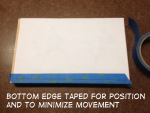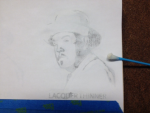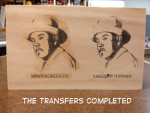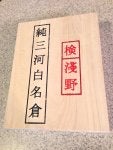We've had an on-again / off-again discussion about transferring laser printed patterns to wood. Barb (outofthewoodwork) has been successfully using wintergreen oil while I have been having good results using lacquer thinner.
I finally got some wintergreen oil and gave the the two methods a side-by-side test. The pattern was printed on my laser printer and taped to a piece of pine so it wouldn't move around. Barb said she uses a Q-tip to apply the oil so I used a Q-tip to apply both the thinner and the oil.
I did the lacquer thinner image first and followed my usual method of lightly rubbing the paper with the lacquer thinner soaked tip. I found when using the oil that I had to burnish harder with the Q-tip than I did with the lacquer thinner so there may be some variance because of the difference in how I burnished each image.
You can see the results in the final photo. From an application standpoint the wintergreen oil is clearly more pleasant to work with and would be the method of choice when working in a small room without good ventilation.
And the Winner Is: Still undecided for me. The two methods yielded remarkably similar results. The oil left residue on the wood that the thinner didn't but that probably isn't an issue when the project is finished. I think you could be happy using either method.
EDIT: Going back and looking at the two transfers an hour or so after taking the pictures I would say the Wintergreen oil gives crisper edges (as seen in the type). Since the lacquer thinner is ... well ... thinner, the image tends to bleed a little. So if fine detail is important, the wintergreen oil may have the edge.
I finally got some wintergreen oil and gave the the two methods a side-by-side test. The pattern was printed on my laser printer and taped to a piece of pine so it wouldn't move around. Barb said she uses a Q-tip to apply the oil so I used a Q-tip to apply both the thinner and the oil.
I did the lacquer thinner image first and followed my usual method of lightly rubbing the paper with the lacquer thinner soaked tip. I found when using the oil that I had to burnish harder with the Q-tip than I did with the lacquer thinner so there may be some variance because of the difference in how I burnished each image.
You can see the results in the final photo. From an application standpoint the wintergreen oil is clearly more pleasant to work with and would be the method of choice when working in a small room without good ventilation.
And the Winner Is: Still undecided for me. The two methods yielded remarkably similar results. The oil left residue on the wood that the thinner didn't but that probably isn't an issue when the project is finished. I think you could be happy using either method.
EDIT: Going back and looking at the two transfers an hour or so after taking the pictures I would say the Wintergreen oil gives crisper edges (as seen in the type). Since the lacquer thinner is ... well ... thinner, the image tends to bleed a little. So if fine detail is important, the wintergreen oil may have the edge.










